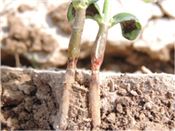|
Soybean Seedling Disease vs. Herbicide Injury
DR. TRAVIS FASKE
LONOKE, ARK.
Seedling diseases of soybean are a chronic problem caused by several soilborne fungi. As the name implies, these diseases occurs at early growth stages (VE to V1), but their symptoms can look similar to herbicide injury. In 2014, cool, wet growing conditions during the early stages of seedling development resulted in several fields with seedlings injured by pre-emergence herbicides. The 2015 cropping season is starting out in a similar fashion so now is a good time to brush up on seedling diseases and how they can be distinguished from herbicide injury.
Seedling diseases are commonly divided into two groups, those that die prior to emergence (pre-emergence damping-off) and those that die shortly after emergence (post-emergence damping-off). Soybean seedling diseases are caused by several soilborne fungi, but fungi from the genera of Pythium spp., Phytophthora spp., and Rhizoctonia solani are the most common. As a general rule, Phythium is most often associated with seed rot or pre-emergence damping off. Seedling tissue near infection points is often soft and mushy (i.e. soft rots). Rhizoctonia is associated with post-emergence damping-off with a dry, reddish-brown lesion on the hypocotyl near the soil line. As a general rule, Pythium spp. is active at cool and warm soil temperatures, whereas Phytophthora spp. and Rhizoctonia solani are most active when soils are warm. These diseases can cause significant impact in poorly drained, excessively compacted, cold and/or wet soils.
Seedling diseases can be reduced by planting high quality seed into warm soils with sufficient moisture for rapid seedling emergence. A fungicide treatment can reduce seedling diseases and improve stand, especially in early planted soybean; however, seed treatments will not improve poor germination or vigor in poor quality seed.
Distinguishing between seedling diseases and herbicide injury is difficult. Generally, seedling diseases are not widespread and occur in localized areas. To complicate matters, both are more severe in poorly drained areas of the field which is related to seedling stress from saturated soils. When herbicide injury is suspected, compare seedling injury to those that may have been over sprayed as is often the case along the edge of the field and look for spray patterns. Seedling injury by herbicides most often appears after a rainfall event during cool, wet weather conditions. Herbicide injury can range from a small, localized lesion on a hypocotyl to large, brown lesion on the hypocotyl at the soil line, which can be misdiagnosed as lesions caused by Rhizoctonia (Fig. 1). Some pre-emergence herbicides can cause brown-to-black lesions on the underside of seedling cotyledons (Fig. 1). Seedlings that sustain minor injury often recover, but in extreme cases, emerging seedlings weakened by cool, wet soils can have severe herbicide injury (Fig. 2) that can result in seedling death. Complete collapse of the hypocotyl of an emerging seedling can be misdiagnosed as seedling disease caused by Pythium spp. It is difficult to determine the causal agent of seedling diseases especially if herbicide injury is involved as many saprophytic and pathogenic fungi will invade dead or injured tissue. Follow label rates and appropriate application timing to minimize herbicide injuries of soybean seedlings. ∆
DR. TRAVIS FASKE: Extension Plant Pathologist, University of Arkansas

Fig. 1. Soybean seedlings with necrotic lesion near soil line and discolored cotyledons due to injured by PPO herbicide.

Fig. 2. Soybean seedlings with varying levels of herbicide injury. First seedling on left has no injury, next two have slight injury, and last two have severe injury.
|
|